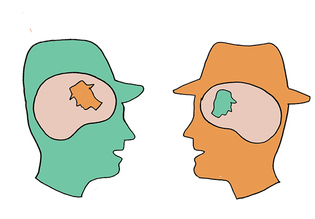
Gregory Nemec
When Olivia Descorbeth ’20 spent two high school summers interning in the laboratory of Yale neuroscientist Joy Hirsch, she developed an idea for an experiment. At Olivia’s school in Great Neck, New York, many of her classmates were wealthier than she. “I wanted to see if, cognitively, there was a distinction between communicating with someone from a similar or dissimilar socioeconomic background,” she says.
Her research proposal fit with Hirsch’s research. As a professor of neuroscience and psychiatry, Hirsch focuses on “two-person neuroscience.” This field uses noninvasive techniques to study brain activity in two people while they interact. Now, Hirsch has an answer to Descorbeth’s question: when speakers differ markedly in education and family income levels, conversation requires more effort. (The results are in Social Cognitive and Affective Neuroscience).
Hirsch asked 79 participants to talk congenially about a topic such as a favorite movie, and had them switch partners to minimize the effects of gender and race. Compared with partners from roughly the same socioeconomic group, discordant dyads reported that their conversations required more work. The view inside their brains confirmed this: there was increased blood flow to the left dorsolateral prefrontal cortex (on the left temple at eye level). Hirsch and colleagues had placed tiny lasers on the speakers’ scalps to measure internal blood flow and oxygen levels that indicate mental effort.
Hirsch finds the results encouraging. “There’s a message here,” she says. “We are not doomed to have conflict. We actually have the neural machinery to implement and assure positive outcomes, to accommodate differences among us.”
 loading
loading